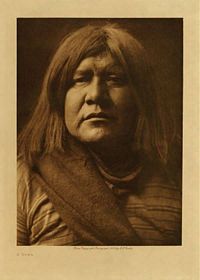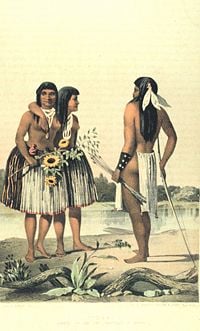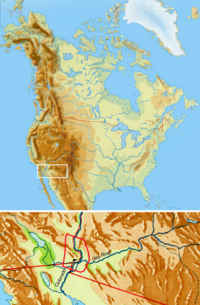Difference between revisions of "Yuman" - New World Encyclopedia
| Line 15: | Line 15: | ||
[[Image:Emory-Yuma.jpg|thumb|right|200px|Yumas. In: "United States and Mexican Boundary Survey. Report of William H. Emory…" Washington. 1857. Volume I.]] | [[Image:Emory-Yuma.jpg|thumb|right|200px|Yumas. In: "United States and Mexican Boundary Survey. Report of William H. Emory…" Washington. 1857. Volume I.]] | ||
| − | The '''Yuman''' (also '''Yuma''', '''Quechan''', '''Kwtsan''', '''Kwtsaan''') are | + | The '''Yuman''' (also '''Yuma''', '''Quechan''', '''Kwtsan''', '''Kwtsaan''') are [[Native Americans in the United States|Native American]]s who live in the lower [[Colorado River]] in [[Arizona]] and [[California]]. |
The Quechan are one of the Yuman tribes. They should not be confused with the [[Quechuas]], which is the term used for several [[ethnic group]]s that use a [[Quechua language]] in South America, particularly in Peru, Ecuador, Bolivia, Chile, and Argentina. | The Quechan are one of the Yuman tribes. They should not be confused with the [[Quechuas]], which is the term used for several [[ethnic group]]s that use a [[Quechua language]] in South America, particularly in Peru, Ecuador, Bolivia, Chile, and Argentina. | ||
| − | + | The Yuman language family is classified within the [[Hokan]] languages. | |
| − | |||
| − | |||
| − | |||
| − | |||
==Population== | ==Population== | ||
| Line 33: | Line 29: | ||
==History== | ==History== | ||
[[Image:Wohngebiet Quechan.png|thumb|right|200 px|Quechan territory]] | [[Image:Wohngebiet Quechan.png|thumb|right|200 px|Quechan territory]] | ||
| − | The | + | The term [[Patayan]] is used by archaeologists to describe the prehistoric Native American cultures that inhabited parts of modern day [[Arizona]], [[California]] and [[Baja California]], including areas near the [[Colorado River]] Valley, the nearby uplands, and north to the vicinity of the [[Grand Canyon]]. These prehistoric people appear to be ancestoral to the Yuman. They practiced [[floodplain]] agriculture where possible, but relied heavily on [[hunter-gatherer|hunting and gathering]]. The historic Yuman-speaking peoples in this region were skilled warriors and active traders, maintaining exchange networks with the [[Pima]] in southern Arizona and with the Pacific coast. |
| − | + | The sixteenth century Spanish expedition under [[Hernando de Alarcón]] meant to be coordinated with [[Francisco Vasquéz de Coronado]]'s overland expedition, visited the peninsula of [[Baja California]] and then traveled along the lower Colorado River, was the first to reach Yuman territory. Until the eighteenth century, however, contact with the Yuman was intermittent. The best crossing point of the Colorado River, just south of its junction with the [[Gila River]], was under Quechan control. The Quechan, warlike in attitude, were constantly fighting other tribes in the area to maintain their superiority. | |
| − | The [[ | + | The first important contact of the Quechan with Europeans was with the Spanish explorer [[Juan Bautista de Anza]] and his party in the winter of 1774. Relations were friendly and on Anza's return from his second trip to Alta California in 1776 the chief of the tribe and three others journeyed to [[Mexico City]] to petition the Viceroy of New Spain for the establishment of a mission. The chief Palma and his three companions were [[baptism|baptized]] there on February 13, 1777. Palma was given the name Salvador Carlos Antonio. |
| + | |||
| + | Spanish settlement among the Quechan did not go as well as hoped and the tribe rebelled on July 17, 1781 and killed four priests and 30 soldiers. The Spanish mission settlements of [[Mission San Pedro y San Pablo de Bicuñer|San Pedro y San Pablo de Bicuñer]] and [[Mission Puerto de Purísima Concepción|Puerto de Purísima Concepción]] were also decimated. The Quechan retained control over the area until the Yuma Expedition, which established [[Fort Yuma]] at the crossing of the Colorado River. This was a military operation to control the unrest of the Yuma in California from December, 1851, to April, 1852, part of the long history of [[Indian Wars]] between the United States and Native Americans that took place before the [[American Civil War]]. | ||
| + | |||
| + | In 1884, a [[Indian reservation|reservation]] was established on the California side of the river for the Yuma. | ||
==Culture== | ==Culture== | ||
| Line 44: | Line 44: | ||
==Contemporary Yuma== | ==Contemporary Yuma== | ||
| − | + | Established in 1884, the '''Fort Yuma Indian Reservation''' has a land area of 178.197 km² (68.802 sq mi) in southeastern [[Imperial County, California]], and western [[Yuma County, Arizona]], near the city of [[Yuma, Arizona]]. The reservation is a part of their traditional lands. | |
Revision as of 16:27, 16 September 2008
| Yuman (Quechan) |
|---|

|
| A Yuma from the collection of Edward S. Curtis |
| Total population |
| 2,000 - 4,000 |
| Regions with significant populations |
| Arizona, California |
| Languages |
| Yuman language (aka Quechan language), English |
| Religions |
| Traditional |
The Yuman (also Yuma, Quechan, Kwtsan, Kwtsaan) are Native Americans who live in the lower Colorado River in Arizona and California.
The Quechan are one of the Yuman tribes. They should not be confused with the Quechuas, which is the term used for several ethnic groups that use a Quechua language in South America, particularly in Peru, Ecuador, Bolivia, Chile, and Argentina.
The Yuman language family is classified within the Hokan languages.
Population
Estimates for the pre-contact populations of most native groups in California have varied substantially (see population of Native California). Alfred L. Kroeber (1925, 883) put the 1770 population of the Quechan at 2,500. Jack D. Forbes (1965, 341-343) compiled historical estimates and suggested that before they were first contacted the Quechan had numbered 4,000 or a few more.
Kroeber estimated the population of the Quechan in 1910 as 750. By 1950, there were reported to be just under 1,000 Quechan living on the reservation and another 1,100+ off it (Forbes 1965, 343). The 2000 census reported a resident population of 2,376 persons on the Fort Yuma Indian Reservation, only 56.8 percent of whom were of solely Native American heritage, and more than 27 percent of whom were white.
History
The term Patayan is used by archaeologists to describe the prehistoric Native American cultures that inhabited parts of modern day Arizona, California and Baja California, including areas near the Colorado River Valley, the nearby uplands, and north to the vicinity of the Grand Canyon. These prehistoric people appear to be ancestoral to the Yuman. They practiced floodplain agriculture where possible, but relied heavily on hunting and gathering. The historic Yuman-speaking peoples in this region were skilled warriors and active traders, maintaining exchange networks with the Pima in southern Arizona and with the Pacific coast.
The sixteenth century Spanish expedition under Hernando de Alarcón meant to be coordinated with Francisco Vasquéz de Coronado's overland expedition, visited the peninsula of Baja California and then traveled along the lower Colorado River, was the first to reach Yuman territory. Until the eighteenth century, however, contact with the Yuman was intermittent. The best crossing point of the Colorado River, just south of its junction with the Gila River, was under Quechan control. The Quechan, warlike in attitude, were constantly fighting other tribes in the area to maintain their superiority.
The first important contact of the Quechan with Europeans was with the Spanish explorer Juan Bautista de Anza and his party in the winter of 1774. Relations were friendly and on Anza's return from his second trip to Alta California in 1776 the chief of the tribe and three others journeyed to Mexico City to petition the Viceroy of New Spain for the establishment of a mission. The chief Palma and his three companions were baptized there on February 13, 1777. Palma was given the name Salvador Carlos Antonio.
Spanish settlement among the Quechan did not go as well as hoped and the tribe rebelled on July 17, 1781 and killed four priests and 30 soldiers. The Spanish mission settlements of San Pedro y San Pablo de Bicuñer and Puerto de Purísima Concepción were also decimated. The Quechan retained control over the area until the Yuma Expedition, which established Fort Yuma at the crossing of the Colorado River. This was a military operation to control the unrest of the Yuma in California from December, 1851, to April, 1852, part of the long history of Indian Wars between the United States and Native Americans that took place before the American Civil War.
In 1884, a reservation was established on the California side of the river for the Yuma.
Culture
Religion
Quechan traditional narratives include myths, legends, tales, and oral histories preserved by the Quechan people. The Southern California Creation myth is particularly prominent in Quechan oral literature. This and other narrative elements are shared with the other Yuman-speaking peoples of southern California, western Arizona, and northern Baja California, as well as with their Uto-Aztecan-speaking neighbors.
Contemporary Yuma
Established in 1884, the Fort Yuma Indian Reservation has a land area of 178.197 km² (68.802 sq mi) in southeastern Imperial County, California, and western Yuma County, Arizona, near the city of Yuma, Arizona. The reservation is a part of their traditional lands.
ReferencesISBN links support NWE through referral fees
- Curtis, Edward S. [1908] 2007. The North American Indian Volume 2. Classic Books. ISBN 1404798021
- DuBois, Constance Goddard. 1908. Ceremonies and traditions of the Diegueño Indians" Journal of American Folk-lore XXI(82): 228-236. Retrieved September 10, 2008.
- Erdoes, Richard, and Alfonso Ortiz. 1985. American Indian Myths and Legends. New York, NY: Pantheon Books. ISBN 0394740181
- Halpern, A. M. 1997. Kar?úk: Native Accounts of the Quechan Mourning Ceremony. Berkeley, CA: University of California Press. ISBN 0520098188
- Hinton, Leanne, and Lucille J. Watahomigie (eds.). 1984. Spirit Mountain: An Anthology of Yuman Story and Song. Tucson, AZ: University of Arizona Press, Tucson. ISBN 0816508178
- Luthin, Herbert W. 2002. Surviving through the Days. Berkeley, CA: University of California Press. ISBN 0520222709
- Waldman, Carl. 2006. Encyclopedia of Native American Tribes. New York, NY: Checkmark Books. ISBN 978-0816062744.
- Kroeber, A. L. [1925] 1976. Handbook of the Indians of California (Bureau of American Ethnology Bulletin 78). Dover Publications. ISBN 0486233685
- Yuma Reservation, California/Arizona United States Census Bureau. Retrieved September 10, 2008.
- Spier, Leslie. [1933] 1978. Yuman Tribes of the Gila River. New York, NY: Dover Publications. ISBN 0486236110
- Bee, Robert L. Bee, and Frank W. Porter. 1989. The Yuma (Indians of North America). Chelsea House Publications. ISBN 1555467377
- Bee, Robert L. 1983. "Quechan." In Handbook of North American Indians. Vol. 10, Southwest, Alfonso Ortiz (ed.), 86-98. Washington, DC: Smithsonian Institution. ISBN 0160045797
- Garrigues, Lisa. 2008. Quechan elders take fight against casino resort to Washington Indian Country Today, August 12, 2008. Retrieved September 7, 2008.
- Fenger, Darin. 2007. Quechan filmmaker says he's grateful for blessings News From Indian Country, 5-27-07. Retrieved September 7, 2008.
External links
- Fort Yuma-Quechan Tribe Inter-Tribal Council of Arizona
- Curtis, Edward S. 1908. The North American Indian
- The River Yuman People Native American Desert Peoples, DesertUSA.
Credits
New World Encyclopedia writers and editors rewrote and completed the Wikipedia article in accordance with New World Encyclopedia standards. This article abides by terms of the Creative Commons CC-by-sa 3.0 License (CC-by-sa), which may be used and disseminated with proper attribution. Credit is due under the terms of this license that can reference both the New World Encyclopedia contributors and the selfless volunteer contributors of the Wikimedia Foundation. To cite this article click here for a list of acceptable citing formats.The history of earlier contributions by wikipedians is accessible to researchers here:
The history of this article since it was imported to New World Encyclopedia:
Note: Some restrictions may apply to use of individual images which are separately licensed.

